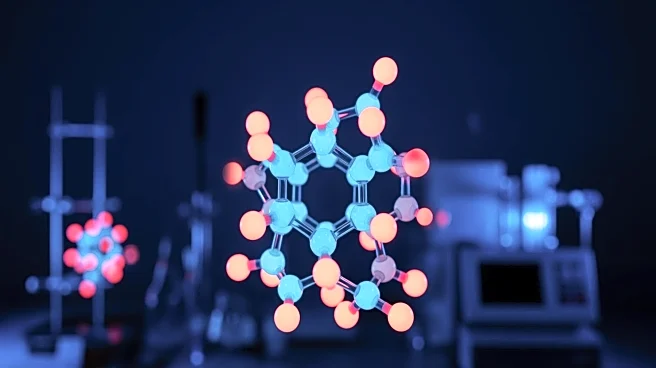What's Happening?
A recent study published in Nature has introduced a novel fluorescent method using boron and nitrogen co-doped graphene quantum dots (BN-GQDs) for the determination of lacosamide in biological samples.
The research involved comprehensive characterization of BN-GQDs, revealing their spherical morphology and uniform size distribution. The method leverages the fluorescence quenching phenomenon, where the presence of lacosamide decreases the fluorescence intensity of BN-GQDs in a concentration-dependent manner. The study employed quantum chemical calculations to explore the interaction between lacosamide and BN-GQDs, identifying potential binding sites and electron transfer mechanisms. The method was optimized using central composite design, focusing on parameters such as pH, buffer volume, and BN-GQDs concentration to maximize fluorescence quenching. Validation of the method demonstrated high sensitivity and selectivity, with limits of detection and quantification significantly lower than the therapeutic range of lacosamide.
Why It's Important?
The development of this fluorescent method for lacosamide detection is significant for pharmaceutical and clinical applications, offering a sensitive and cost-effective alternative to conventional techniques like HPLC and LC-MS/MS. The method's high sensitivity and rapid analysis time make it suitable for therapeutic drug monitoring and pharmacokinetic studies, potentially improving patient care by enabling precise dosage adjustments. Additionally, the use of BN-GQDs reduces environmental impact compared to traditional methods that require substantial organic solvent consumption. This advancement could lead to more sustainable practices in pharmaceutical analysis, aligning with global efforts to minimize environmental footprints in scientific research.
What's Next?
The study suggests further exploration of BN-GQDs for other pharmaceutical compounds, potentially expanding their application in drug monitoring and environmental analysis. Researchers may focus on enhancing the method's automation and miniaturization to facilitate widespread adoption in clinical laboratories. Additionally, the integration of this method into routine pharmaceutical quality control processes could be pursued, given its demonstrated reliability and environmental benefits. Collaboration with industry stakeholders might accelerate the transition to greener analytical practices, promoting sustainability in pharmaceutical research and development.
Beyond the Headlines
The use of BN-GQDs in analytical chemistry represents a shift towards more environmentally friendly methodologies, addressing the growing concern over the ecological impact of scientific research. This approach not only reduces hazardous waste but also aligns with the principles of green chemistry, emphasizing the importance of sustainability in innovation. The successful application of BN-GQDs in lacosamide detection may inspire similar advancements across various fields, encouraging the adoption of quantum dot technology in diverse analytical applications.











